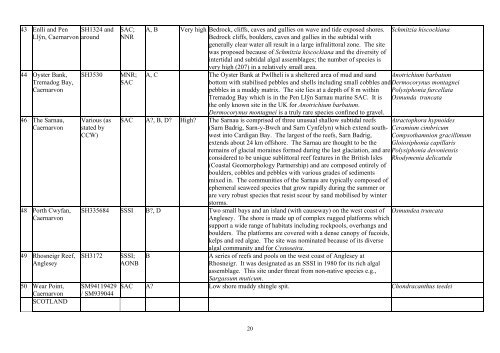Important Plant Areas for algae - Natural History Museum
Important Plant Areas for algae - Natural History Museum
Important Plant Areas for algae - Natural History Museum
You also want an ePaper? Increase the reach of your titles
YUMPU automatically turns print PDFs into web optimized ePapers that Google loves.
43 Enlli and Pen SH1324 and<br />
Llŷn, Caernarvon around<br />
44 Oyster Bank,<br />
Tremadog Bay,<br />
Caernarvon<br />
46 The Sarnau,<br />
Caernarvon<br />
48 Porth Cwyfan,<br />
Caernarvon<br />
49 Rhosneigr Reef,<br />
Anglesey<br />
50 Wear Point,<br />
Caernarvon<br />
SCOTLAND<br />
SH3530<br />
Various (as<br />
stated by<br />
CCW)<br />
SAC;<br />
NNR<br />
MNR;<br />
SAC<br />
A, B Very high Bedrock, cliffs, caves and gullies on wave and tide exposed shores.<br />
Bedrock cliffs, boulders, caves and gullies in the subtidal with<br />
generally clear water all result in a large infralittoral zone. The site<br />
was proposed because of Schmitzia hiscockiana and the diversity of<br />
intertidal and subtidal algal assemblages; the number of species is<br />
very high (207) in a relatively small area.<br />
A, C The Oyster Bank at Pwllheli is a sheltered area of mud and sand<br />
bottom with stabilised pebbles and shells including small cobbles and<br />
pebbles in a muddy matrix. The site lies at a depth of 8 m within<br />
Tremadog Bay which is in the Pen Llŷn Sarnau marine SAC. It is<br />
the only known site in the UK <strong>for</strong> Anotrichium barbatum.<br />
Dermocorynus montagnei is a truly rare species confined to gravel.<br />
SAC A?, B, D? High? The Sarnau is comprised of three unusual shallow subtidal reefs<br />
(Sarn Badrig, Sarn-y-Bwch and Sarn Cynfelyn) which extend southwest<br />
into Cardigan Bay. The largest of the reefs, Sarn Badrig,<br />
extends about 24 km offshore. The Sarnau are thought to be the<br />
remains of glacial moraines <strong>for</strong>med during the last glaciation, and are<br />
considered to be unique sublittoral reef features in the British Isles<br />
(Coastal Geomorphology Partnership) and are composed entirely of<br />
boulders, cobbles and pebbles with various grades of sediments<br />
mixed in. The communities of the Sarnau are typically composed of<br />
ephemeral seaweed species that grow rapidly during the summer or<br />
are very robust species that resist scour by sand mobilised by winter<br />
storms.<br />
SH335684 SSSI B?, D Two small bays and an island (with causeway) on the west coast of<br />
Anglesey. The shore is made up of complex rugged plat<strong>for</strong>ms which<br />
support a wide range of habitats including rockpools, overhangs and<br />
boulders. The plat<strong>for</strong>ms are covered with a dense canopy of fucoids,<br />
kelps and red <strong>algae</strong>. The site was nominated because of its diverse<br />
algal community and <strong>for</strong> Cystoseira.<br />
SH3172<br />
SM94119429<br />
/ SM939044<br />
SSSI;<br />
AONB<br />
B A series of reefs and pools on the west coast of Anglesey at<br />
Rhosneigr. It was designated as an SSSI in 1980 <strong>for</strong> its rich algal<br />
assemblage. This site under threat from non-native species e.g.,<br />
Sargassum muticum.<br />
Schmitzia hiscockiana<br />
Anotrichium barbatum<br />
Dermocorynus montagnei<br />
Polysiphonia furcellata<br />
Osmunda truncata<br />
Atractophora hypnoides<br />
Ceramium cimbricum<br />
Compsothamnion gracillimum<br />
Gloiosiphonia capillaris<br />
Polysiphonia devoniensis<br />
Rhodymenia delicatula<br />
Osmundea truncata<br />
SAC A? Low shore muddy shingle spit. Chondracanthus teedei<br />
20

















